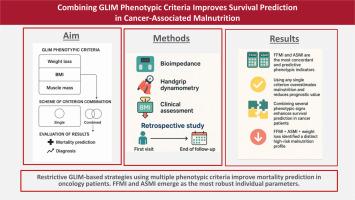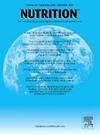Combining GLIM phenotypic criteria improves survival prediction in cancer-associated malnutrition
IF 3
3区 医学
Q2 NUTRITION & DIETETICS
引用次数: 0
Abstract
Objectives
To evaluate the diagnostic agreement among GLIM phenotypic criteria, compare prevalence estimates based on individual and combined criteria, and assess their prognostic value for mortality in oncology patients.
Methods
A retrospective cohort study was conducted in adult patients with active solid tumors referred for nutritional assessment at a tertiary hospital. GLIM phenotypic criteria were assessed using multiple tools, including calf circumference, fat-free mass index (FFMI), appendicular skeletal muscle mass index (ASMI), and handgrip strength. Agreement was evaluated using Cohen’s Kappa and intraclass correlation coefficients. Malnutrition prevalence and its association with mortality were analyzed using inclusive (any criterion met) and restrictive (all criteria met) combinations. Cox regression models adjusted for tumor type, metastatic stage, time since diagnosis, and prolonged hospitalizations were used to estimate hazard ratios.
Results
The study included 209 patients (mean age 65 years, SD 14; 28.7% female). The median follow-up was 24.1 months (IQR 15.0). Agreement among phenotypic criteria was generally low (Kappa <0.4), except for FFMI and ASMI (ICC = 0.847). Inclusive strategies showed higher malnutrition prevalence (up to 75.6%) but limited prognostic value. Restrictive strategies demonstrated stronger associations with mortality. The combination of BMI, weight loss, FFMI, and ASMI yielded the highest prognostic value (HR 2.98; 95% CI: 1.47–6.01; AUC 0.83). Simpler combinations, such as BMI + FFMI, also showed clinical relevance.
Conclusions
Restrictive GLIM-based strategies using multiple phenotypic criteria improve mortality prediction in oncology patients. FFMI and ASMI emerge as the most robust individual parameters.

结合GLIM表型标准可改善癌症相关营养不良患者的生存预测。
目的:评估GLIM表型标准的诊断一致性,比较基于单个标准和联合标准的患病率估计,并评估其对肿瘤患者死亡率的预后价值。方法:回顾性队列研究对某三级医院转诊的成人活动性实体瘤患者进行营养评估。使用多种工具评估GLIM表型标准,包括小腿围、无脂质量指数(FFMI)、阑尾骨骼肌质量指数(ASMI)和握力。使用Cohen’s Kappa和类内相关系数评估一致性。采用包容性(满足任何标准)和限制性(满足所有标准)组合分析营养不良患病率及其与死亡率的关系。采用校正肿瘤类型、转移期、诊断后时间和住院时间的Cox回归模型来估计风险比。结果:209例患者入组,平均年龄65岁,SD 14,女性28.7%。中位随访为24.1个月(IQR为15.0)。表型标准之间的一致性普遍较低(Kappa结论:使用多种表型标准的限制性基于glimm的策略可提高肿瘤患者的死亡率预测。FFMI和ASMI是最稳健的单独参数。
本文章由计算机程序翻译,如有差异,请以英文原文为准。
求助全文
约1分钟内获得全文
求助全文
来源期刊

Nutrition
医学-营养学
CiteScore
7.80
自引率
2.30%
发文量
300
审稿时长
60 days
期刊介绍:
Nutrition has an open access mirror journal Nutrition: X, sharing the same aims and scope, editorial team, submission system and rigorous peer review.
Founded by Michael M. Meguid in the early 1980''s, Nutrition presents advances in nutrition research and science, informs its readers on new and advancing technologies and data in clinical nutrition practice, encourages the application of outcomes research and meta-analyses to problems in patient-related nutrition; and seeks to help clarify and set the research, policy and practice agenda for nutrition science to enhance human well-being in the years ahead.
 求助内容:
求助内容: 应助结果提醒方式:
应助结果提醒方式:


